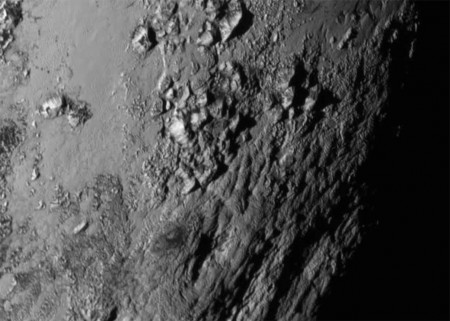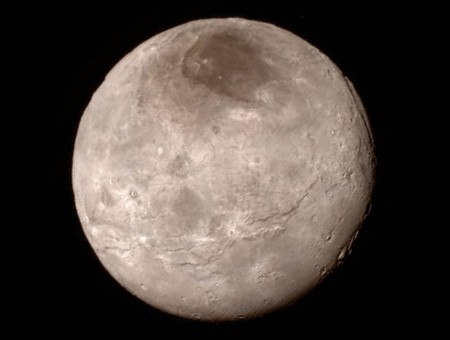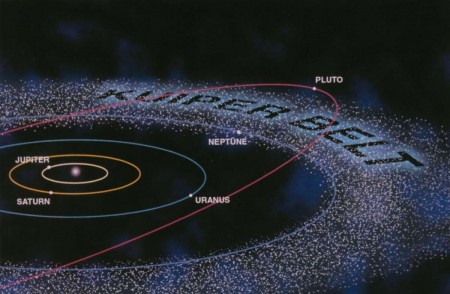July 15, 2015 – The first close up of Pluto shows a mountainous surface some reaching a height of more than 3,330 meters (about 11,000 feet).
Pluto’s largest moon, Charon (seen below) exhibits a dark spot at its North Pole which has been nicknamed Mordor after Tolkien’s mythical land in The Lord of the Rings.
What truly makes these pictures so remarkable is that we can see them at all considering the amount of sunlight that actually reaches Pluto and its moons. Pluto lies 40 times further away from the Sun than Earth. The light reaching the dwarf planet surface is 1,000 times dimmer than what we see. If we were to stand on Pluto’s surface the Sun would be a distant point of light (see an artist’s impression in the image below of what a person standing on Pluto would see). It certainly would be brighter than a night here on Earth with a full Moon. And sometimes when the Moon is bright you can almost read by it. But still, you can’t help but think shouldn’t these pictures be darker?
So how come they are not?
Of the seven instruments on board New Horizons, three are optical. The pictures we saw a few days ago as the spacecraft approached the planet were shot by the Long-Range Reconnaissance Imager (LORRI). It provides high-resolution monochrome images.
The second optical instrument is the Ralph telescope, a visible-light imager capable of seeing in color and near-infrared. And the third is known as Alice, an ultraviolet imaging spectrometer. Ralph and Alice, named after characters in the old situation comedy, The Honeymooners, constitute the cameras that are performing most of the detailed imaging of the Plutonian system and the dwarf planet’s surface and they have completed this task while flying through the system at speeds of 14 kilometers per second passing 12,500 kilometers from the Pluto’s surface in lighting conditions a little brighter than night here on Earth with a full Moon.
In addition the images that have been captured for download to us over the next sixteen months required New Horizons to lock on to not just Pluto and Charon, but the four other moons, Styx, Nix, Kerberos and Hydra in the Plutonian system. I don’t know about you but I am looking forward to seeing what these amazing instruments have captured under conditions that one would think would produce a lot of blur.
And even after New Horizons has transmitted the last image and data packet from the Pluto flyby it will continue to operate with its nuclear power plant, a radioisotope thermoelectric generator, for another 20 plus years. NASA hopes New Horizons will encounter a number of Kuiper Belt Objects (KBOs) of which there are more than 100,000 as it flies outward. Three of these varying in size from 20 to 55 kilometers (12 to 34 miles) in diameter, identified by the Hubble Space Telescope, lie in New Horizons path and should the spacecraft remain healthy and NASA continue to be able to fund the mission, we may see some additional close encounters at the outer fringe of our Solar System.
Why study KBOs? Because they are the fossil record for the Solar System. They lie far away from the Sun, permanently refrigerated, with all the secrets of the origin of our system and what eventually became all the other planets, comets and asteroids, Earth and us.
Once past the Kuiper Belt, New Horizons will like its predecessors, Voyager 1 and 2, reach into the outer edges of the heliosphere and eventually the boundary where the Sun’s solar winds meet interstellar space, transmitting data back to Earth for many years to come before its power source dies.


















